The life cycle of a new fossil: Meet the ancient cousin of the earthworm
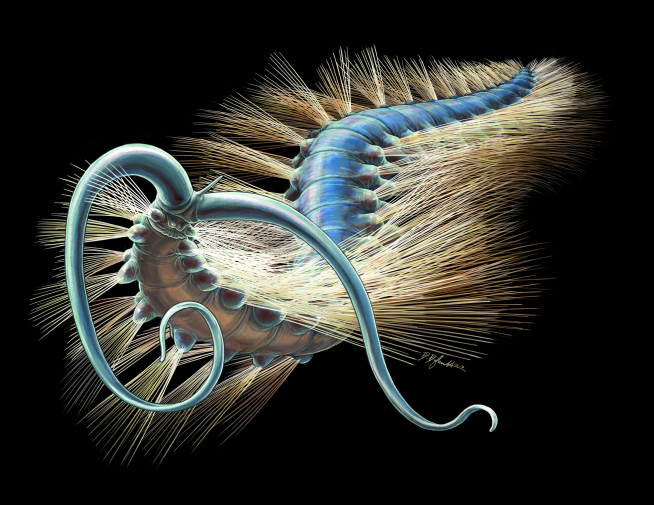
By Karma Nanglu
Have you ever wondered how a new fossil is described? Or picked up an earthworm on a rainy day and thought to yourself “where do animals like these come from?” In this ROMblog post, I’ll walk you through the process of describing an exceptionally well-preserved new fossil species from the half-a-billion year old Burgess Shale and give you an inside look into some of the tools and techniques that we use in our work when studying fossils from this famous site. This “life cycle” in the discovery and description of a new fossil species will take us from the Rocky Mountains of British Columbia to a special display case at the Royal Ontario Museum where you can admire this new species.
My name is Karma Nanglu and I’m a PhD candidate at the University of Toronto and Royal Ontario Museum. Along with my supervisor, Senior Curator of Invertebrate Palaeontology Dr. Jean-Bernard Caron, we have described a new species of ancient marine worm from the half-a-billion year old Burgess Shale in the Canadian Rockies which is now published in and featured on the cover of the journal Current Biology. Despite being an oceanic animal, this new fossil species is an ancient cousin to the earthworms you can find in your garden. This worm possesses a unique anatomy which tells the story of how the head of these animals evolved (you can read more about the significance of this new study here ).
Our new fossil species was discovered from the Marble Canyon fossil site located in Kootenay National Park, British Columbia. It was discovered in 2012 by a ROM research team led by Dr. Caron, and is part of the famous Burgess Shale site in the Canadian Rockies. The fossils of the Burgess Shale critically document a phenomenon called the Cambrian Explosion, the first indisputable evidence of most modern animal groups in the fossil record. In 2014 and 2016, Dr. Caron led two further ROM research expeditions to the Marble Canyon totaling approximately 3 months of field work, which I was fortunate enough to be a part of.
In total, we have collected over 20,000 observations of fossil animals at Marble Canyon, with over 500 of them being the new species described today. This new worm is a particularly crucial find, as fossil worms are far less common than animals with hard parts like bones (vertebrates such as dinosaurs), exoskeletons (arthropods such as insects and crustaceans) or shells (mollusks such as snails). The result is that the evolutionary history of many soft bodied animal groups is not very well documented due to a lack of information regarding what they looked like near their origins and how they changed over geological time. The stunning abundance of this new worm and other soft bodied fossils at Marble Canyon underscores the exceptional nature of the Burgess Shale. My PhD thesis is concerned with analyzing all of these observations together, including this new species we've described, to give us a window into how the community of animals that lived at Marble Canyon 508 million years ago would have lived.
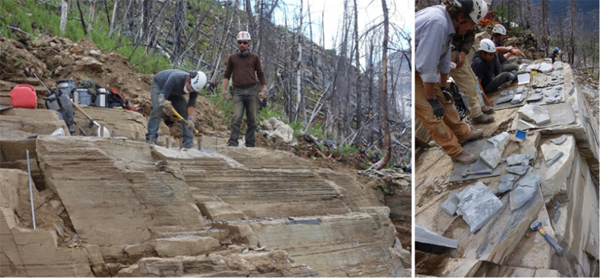
Pictured below is the “holotype” of the newly described animal, Kootenayscolex barbarensis, which means that it is the specimen chosen to be the exemplar against which other specimens are compared to determine if they’re the same species. The finely preserved features of the specimen make it not only beautiful, but immediately recognizable to researchers as belonging to a group of animals called the annelids or “ringed worms.”
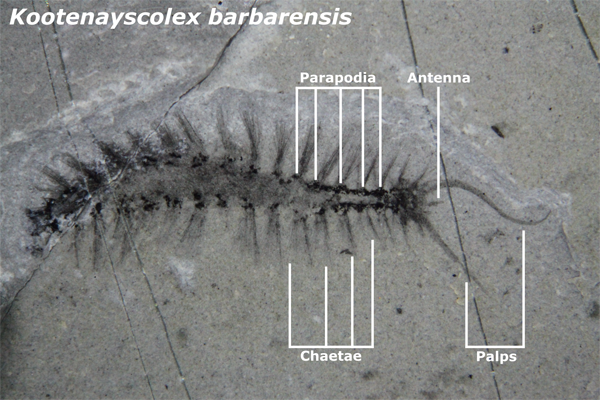
Modern annelids include the familiar earthworms and leeches, and also a variety of marine worms called polychaetes that you may be less aware of, but which are critical components of many ocean ecosystems. Polychaetes come in all shapes and sizes, and can be found in almost any marine aquatic environment you can think of: tropical beaches to the arctic, hydrothermal vents to the open ocean. Kootenayscolex was one of the earliest representatives of this group, crawling around the sea floor 508 million years ago.
Naming a new species is an essential part of the scientific process, and can often be one of the most fun. In this case, we chose the first part of its name to convey information about where the animal was found (Kootenay National Park) as well as the type of animal it is (scolex – Greek for “worm”). The second part of its name was chosen to honour Barbara Polk Milstein, a long-standing supporter of Burgess Shale research including our field work to Marble Canyon.
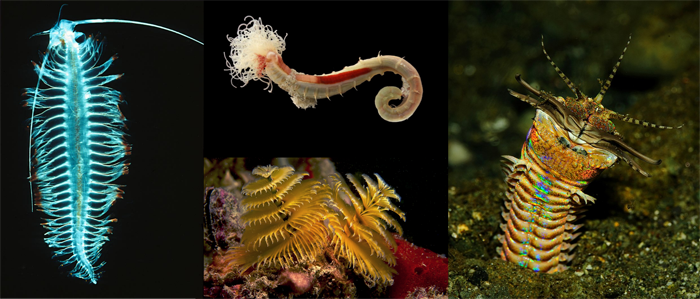
During the time of the Burgess Shale, animals tended to be a lot smaller and Kootenayscolex is no exception, usually measuring in at about 2.5cm in total length. Visualizing such tiny animals is difficult so scientists use a variety of tools to achieve this. The first step to getting a clearer picture of the animal is preparing the fossil. Rarely are fossils revealed in perfect, display quality condition when the rock entombing them is split open. For Burgess Shale fossils, preparation involves removing parts of the surrounding rock that overlay the fossil itself. This is done by using a small micro-engraving tool similar to a dentist’s drill. The fossils are then studied under a microscope using various lighting conditions to see different details of the anatomy of the animal. Other more advanced imaging techniques can be used as well. For example, a technique called elemental mapping was used to see which elements were preserved along the fossil. This can give us an idea about fossilization processes of different types of tissues.
This process can be seen in the image below: the first image shows parts of the rock that were covering the fossil and had to be broken away in red, the second is how the animal would look to us under a microscope (the whole fossil is only 1.5cm long), and the last shows the results of elemental mapping with the elements of interest for our research shown in green.
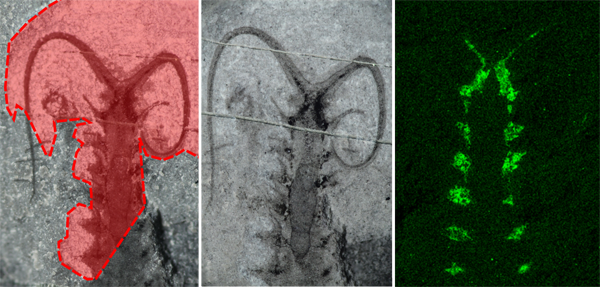
After the morphology of the new species is fully understood, palaeontologists often collaborate with artists to help bring long extinct animals to life. For this project we worked with ROM palaeoartist Danielle Dufault on two separate components. The first were a set of technical, schematic drawings of the anatomy of Kootenayscolex. Our description involved observations of hundreds of specimens in varying angles, qualities of preservation, and levels of completeness. While this gives us a comprehensive understanding of the fossil, it can be difficult to accurately and succinctly present a summary of this information. Technical drawings help considerably in this effort, drawing attention to areas of interest while allowing us to succinctly visualize the anatomy of the animal.
The second component was producing a life reconstruction of the animal, which is essentially an artistic interpretation of how the animal would have looked like alive. In this case, Kootenayscolex was brought back to life as a worm crawling around with its various sensory appendages pointed out to feel its way forward (it seems like these worms hadn't evolved eyes yet). The bristles closest to the ground were used to help propel the animal forward, while those on its back were used as a defense against predators. The colour and texture of the cuticle (the protective outer layer of the worm) was inspired by modern polychaetes such as the ragworms.

The end result of these many hours of work is writing up the details of your findings. This can include highly technical reports that are meant to be read by other specialists in the scientific community (in this case Current Biology ), but also write-ups for the general public like this blog post and our ROM Press Release, as well as interviews with news outlets (see an updated list of press coverage below). Finally, the new animal is ready for its moment in the spotlight, in this case being placed in a rotating research exhibit in the ROM Dawn of Life Preview Gallery which you can find on level 3. This gallery is an early look at a planned exhibit on the origin of life to the first dinosaurs.
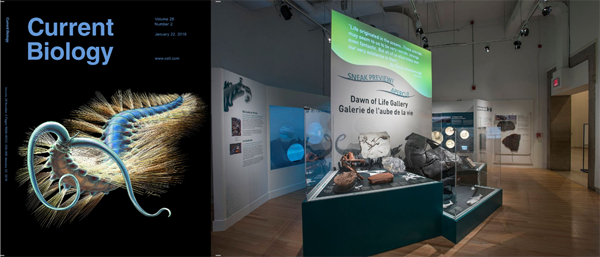
To end this blogpost, I should also mention that January 28th 2018 will be Fossil Fest Family Sunday at the ROM where a number of researchers, including myself, will be giving talks on ongoing fossil research at the ROM and the University of Toronto. We hope to see you there, and I’d love to answer any questions you’ve got about fossils, worms and the dawn of animal life!
News coverage for Kootenayscolex barbarensis:
CBC News - More than 500 fossils of new ancient worm species found in B.C.
LiveScience - 508-Million-Year-Old Bristly Worm Helps Solve an Evolutionary Puzzle
National Post - New 508-year old bristle worm found at Burgess Shale fossil site in B.C.
For more about this research and other Burgess Shale research see:
Karma Nanglu on Twitter: @KNanglu
Karma Nanglu’s website: https://saccoglossus.wordpress.com/
ROM Media Release: Kicking an Old Can of Worms – the Origin of the Head in Annelids
The research paper was published in the journal Current Biology, A New Burgess Shale Polychaete and the Origin of the Annelid Head Revisited. DOI #10.1016/j.cub.2017.12.019
Website: The Burgess Shale, Virtual Museum of Canada, by Royal Ontario Museum and Parks Canada
Royal Ontario Museum Burgess Shale Projects
The Royal Ontario Museum’s Dawn of Life Gallery preview exhibition
